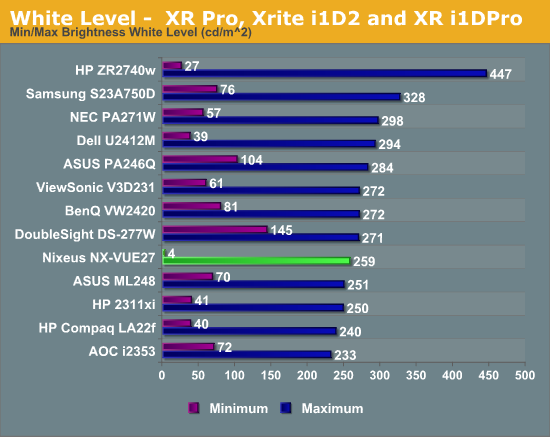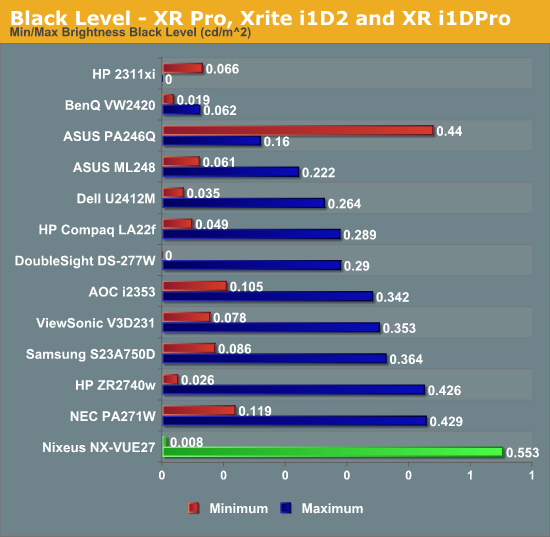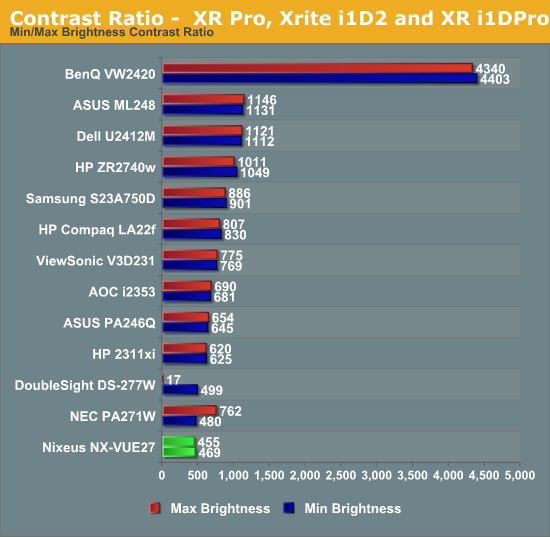Nixeus NX-VUE27 27" Monitor: High Resolution for the Masses
by Chris Heinonen on September 20, 2012 6:10 PM ESTBrightness and Contrast
For this review, I altered the way I measure brightness and contrast. With display vendors including dynamic modes that shut off the backlight completely on all-black screens, those can’t be used for testing anymore as it leads to infinite contrast ratios. Additionally it doesn’t do a real world, accurate test of what the real contrast and brightness levels would be. Instead I am now measuring the screen using a 5x5 ANSI contrast pattern, once regular and once reversed. This allows for getting a better idea of panel response, and it will reward companies that use better backlighting systems (like LED array systems) that have precise control, less backlight bleeding, or that move to a technology like OLED in the future.
The downside is that new results are not directly comparable to old results. It also doesn’t scale well from a large display to a smaller display, as the smaller targets on small displays mean you might more easily read light from another target. I would expect that numbers now will look a little worse than before because of the harder testing, and nowhere near the ridiculous numbers often quoted by vendors. It will provide better data for the readers, however, and so it is the way to move forward.

With the brightness set to maximum we get a white level in the center of the ANSI pattern of 259 nits. This is lower than I expected from the specs, but a full field white might be able to generate a brighter square as well. For the minimum white level I set the brightness level down to 20. With it set to 19 I could get a reading on white of around 1 nit, but black was below what the meter could read, and so I had to set it up to 20. Set here, I had 3.8 nits of light output (which is rounded up to 4 in the chart). Some displays only get down to 70-80 nits, which might be brighter than some users want, so this is a good number to see. I just wish the brightness control functioned all the way down to 0 to provide better control of the backlight overall.

The black level of the Nixeus with the backlight set to maximum is 0.553. This seems high, but this is our first pass with the new ANSI testing method, so we will have to see if this winds up being high or low after a couple more reviews. The black level of the Nixeus with the brightness at 20 is 0.008 nits, which is quite low. It’s really as low as we’ve measured before, but this is somewhat a result of a backlight that stops being functional below this setting.

The resulting contrast ratios here are 469:1 at maximum and 455:1 at minimum. These unfortunately come in at the bottom of the list for 27” monitors--and really it's the bottom of the chart for all the monitors we have reviewed recently. Getting good contrast ratios becomes harder as the display gets larger, and the backlighting systems to really pull them off become more expensive. I think we are almost stuck with these lower contrast ratios until we start to see more screen innovations, like OLED or backlit-LED array displays, but those are also very expensive. I’m not too happy about the sub-500:1 number as dynamic range is very important in a display, but it’s a compromise you’ll have to weigh yourself.










66 Comments
View All Comments
sheh - Thursday, September 20, 2012 - link
Too bad they kept the size and reduced the resolution rather than vice versa. :)Confusador - Friday, September 21, 2012 - link
Amen! I really want this resolution, but can't stand anything bigger than 23"falko2904 - Friday, September 21, 2012 - link
But that Dell is significantly lower resolution. It is only 1920x1080 (actually fine by me for what I would want). The class of monitors being talked about have 2560x1440 resolution.LIke I said, for my purpose, I actually like that Dell.
ikoss - Friday, September 21, 2012 - link
Dude.. that's 1080p crap, not to mention not likely to be an IPS!DanNeely - Sunday, September 23, 2012 - link
It's listed as IPS on the spec page; might only be eIPS though.Sabresiberian - Friday, September 21, 2012 - link
1920x1080 @ 27" might be fine for a TV across the living room, but it's crap for a monitor.RaistlinZ - Thursday, September 20, 2012 - link
Poor contrast, poor color gamut, high input lag, high power draw, mediocre build quality.You get what you pay for.
cheinonen - Friday, September 21, 2012 - link
I'm just going to suggest you didn't fully read the article or didn't look at similar displays in the results tables. The contrast was poor in comparison to the HP 27" display, but was close to the results from the NEC and DoubleSight panels. The color gamut is sRGB, exactly what it was specified for, and exactly what you get. The power draw was lower than all the other tested 27" displays, so that was good, and I commented plenty on the build quality.With input lag, other than the HP ZR2740w, which has no scaler, the input lag on all the other 27" models is almost identical (and the new review has the same issue). Whatever scaler is being used isn't incredibly fast, and combined with the response time of the display, the absolute minimum you are going to get is 1 frame. If you run at 1440p, you might get exactly 1 frame, but as I said, I have no way of knowing this. So in comparison to 27" displays, the lag, gamut, contrast, and power draw are either close to the same or better in most cases, with the build quality being the main issue in comparison.
sheh - Thursday, September 20, 2012 - link
...in case manufacturers scour the web for public opinion. :)Still waiting for hi-res in DPI rather than absolute number of pixels. And enough with 16:9. OLED aside, wanted: 3840x2400 in 24". If they don't start upping the DPI in desktop, soon enough cellphones will become higher-res (in pixels) than desktop monitors.
magreen - Thursday, September 20, 2012 - link
This.It's long past time for graphics drivers and operating systems to treat displays as a resolution independent output device, the way printers are. When you print a document to a printer that can print 600 dpi, it looks just like that same document printed on a 300 dpi printer except a bit sharper.
I'm so tired of having to blow up pdfs and word documents to much larger than their actual size because otherwise I can't read the smaller text (even if I put my face close to the monitor).